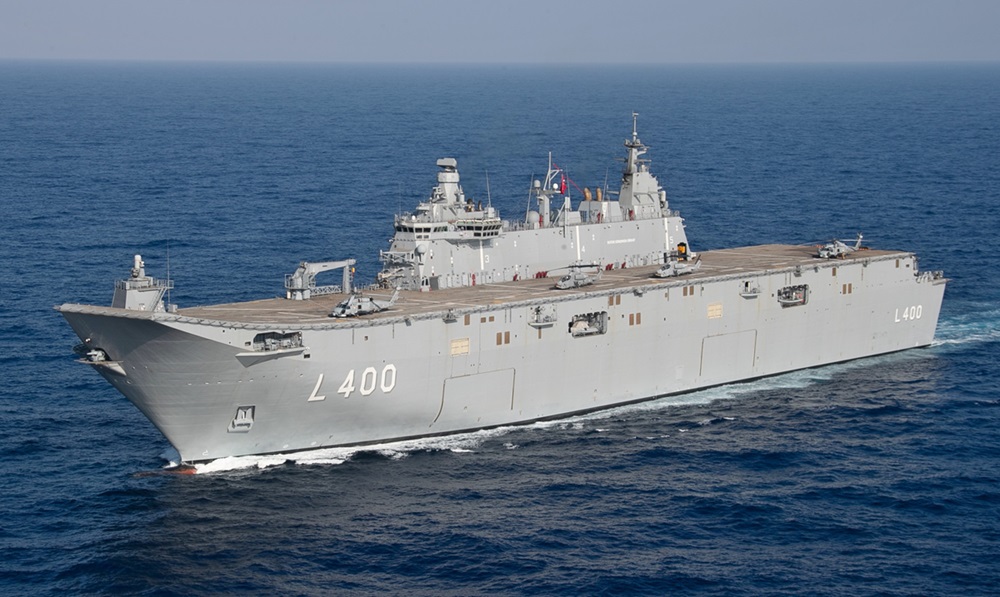Turkish Navy Shares Aircraft Carrier and Air Defence Ship Designs
In April the Turkish Navy shared its preliminary design of the future aircraft carrier and air defense warship. These are two of the most important ship construction projects the Turkish Navy, defense establishment, and shipbuilding industry will focus on in the next couple of decades. The third project is the construction of an indigenous submarine.

According to information shared by the Turkish Navy, the ship will be 285 meters long and 75 meters wide, with a draft of 10 meters and a projected displacement of 60,000 tons, making it more than twice the displacement of the current largest warship in the Turkish Navy, the TCG Anadolu. The dimensions are very similar to those of the Queen Elizabeth class carriers.
The aircraft carrier will be in a short take-off and barrier arrested recovery configuration, with a single runway and ski jump approximately 12-14 degrees. This configuration is feasible and realistic since it is unlikely for the USA to provide catapult technology to Turkey. Furthermore, it will ease the work of Turkish aircraft designers and engineers as they will not have to reconfigure their planes and landing gears for catapult launching.
The design shows a single island on the starboard side. One plane elevator is before the island and the second one aft. The preliminary design shows three possibly take off spots. The shortest one, located with the level of the bridge is for the TB-3 UCAV. The second spot diagonally across the ship on her port side is for the Hürjet manned aircraft. And the furthest spot, nearest to the port quarter is for the Kızılelma unmanned jet aircraft. To land the aircraft there are three arresting wires and an angled deck.
The ship will have a COGAG configuration with four gas turbines, probably GE LM2500, as this type of turbines is already used by various warships in the Turkish Navy, with an estimated speed of 25 knots.
An aircraft carrier procurement is a very ambitious project with political backing. A decision to inaugurate an aircraft design office was made during a meeting of the Defense Industry Executive Committee (SSIK), chaired by Turkish President Recep Tayyip Erdoğan, held on January 3rd.
The amphibious landing ship TCG Anadolu has been presented to the public as an aircraft carrier, but obvious shortcomings and challenges have emerged regarding its suitability for this role. Issues such as Turkey's rejection from the F-35 project and the incompatibility of existing Turkish aircraft development programs with the ship's current structure have raised concerns about the feasibility of utilizing the vessel as an aircraft carrier.
Since the new design does not show any provision for amphibious operations such as a well deck or ramps for loading and unloading of vehicles, it can be assumed that the Turkish Navy wishes to have a purely dedicated aircraft carrier without any additional amphibious capabilities.
The Turkish Navy does not intend to receive technical support from a foreign company for the national aircraft carrier, which will be entirely designed by the Design Project Office Directorate and constructed by Turkish engineers and workers at İstanbul Naval Shipyard Command. Within the Design Project Office (DPO) Directorate, a 110-person Aircraft Carrier Working Group has been established, and the team has begun conceptual design by dividing into subgroups according to expertise.
The TF-2000 will be the Turkish Navy’s principal air defense warship, similar to the Turkish Type 45. Its principal mission will be to detect and destroy guided missiles.
The design office started working in 2017, and until then, the design of the warship has changed a couple of times. In its latest form, the ship is 149 meters long and 21.3 meters wide, with a draft of 5.75 meters and a displacement of 8,300 tons. In its previous version shared in 2021, the ship was 166 meters long and 21.5 meters wide, with a displacement of 8,500 tons.
Its main machinery is in the so-called CODOG configuration, which is expected to help the vessel reach 26 knots or more. The ship will feature one 127mm main gun, two 25mm remote-controlled weapon stations, and one 35mm Gökdeniz close-in weapon system.
The TF-2000 will feature 32-cell VLS at the bow and 64-cell VLS launchers amidships, totaling 96 cells for Midlas vertical launch systems designed in Turkey. The principal weapons for the VLS will be the Siper and Hisar air defense missiles. The number of Quad-Pack capable cells in the MİDLAS VLS, which is expected to be Strike length, will be determined over time The navy had previously stated that the TF-2000 would be fitted with Gezgin cruise missiles launched from vertical launch systems. An important change is the elimination of Atmaca anti-ship missiles. The old version of the ship had 16 Atmaca antiship missile canisters. These do not exist in the new version. It is not clear at the moment whether vertical firing versions of these missiles will be.
The Çafrad multi-function phased array radar arrays will be integrated into the ship both at the bow and stern in separate compartments. The choice of separate array/mast placement is preferred to enable unrestricted 360-degree scanning, target detection, and tracking without any visual obstruction. In the new Çafrad system configuration, two fixed S-Band Long-Range Radar are placed on the ship's starboard and port sides superstructure at the bow, while the other two fixed arrays are mounted on the mast at the stern. In addition to its early warning capability, this radar will also provide guidance for Hisar and Siper missiles to the target. The phased array antennas of the X-Band multi-function radar, which will focus solely on surface engagement, are located on the integrated main mast. The standard detection range for Çafrad is expected to be 450 km+, with a target detection range of 750 km at full power.
The unveiling of the aircraft carrier design signals Turkey's strategic focus on bolstering its maritime strength and regional influence. Additionally, the TF-2000 project, aimed at developing the Turkish Navy’s principal air defense warship, reflects the nation's determination to enhance its defense capabilities independently.
These projects represent a significant milestone for the Turkish shipbuilding industry, aiming to achieve self-sufficiency in designing and constructing sophisticated naval vessels. While specific details regarding procurement, budget allocation, and project timelines remain unclear, the unveiling of these designs marks a crucial step forward in Turkey's quest for naval modernization and self-reliance. Logical sequencing suggests that the procurement of TF-2000 air defense warships will precede the aircraft carrier project, underlining strategic prioritization and planning within the Turkish Navy's modernization efforts.

















YAZIYA YORUM KAT
Türkçe karakter kullanılmayan ve büyük harflerle yazılmış yorumlar onaylanmamaktadır.